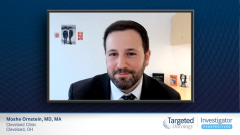
Subgroup Analyses of the CLEAR study in mRCC
An overview of data demonstrated by other investigational studies of lenvatinib plus pembrolizumab as frontline therapy for metastatic renal cell carcinoma.
Episodes in this series

Transcript:
Moshe Ornstein, MD, MA: After we look at the high-level results of response rate, complete response rates, PFS [progression-free survival], overall survival, it’s interesting to look at some of the other end points and to look at some subgroup analyses as well. In particular, it’s interesting to look at health-related quality of life. Why is this so important? If we see additive or synergistic activity by adding 1 treatment to another treatment, there’s going to be a concern that when you combine 2 different agents that you’re going to be adding toxicity as well. It’s important to balance the quality and quantity of life of patients, and look at quality of life data. It’s hard to compare these across trials because there are different quality of life tools and surveys that are used. There are different time points that they’re given. Within this trial, I want to take a look at the quality of life in patients receiving lenvatinib [Lenvima] and pembrolizumab [Keytruda] versus those receiving sunitinib [Sutent]. Although we might expect that in the sunitinib arm, there’s just a TKI [tyrosine kinase inhibitor] and in the immunotherapy with pembrolizumab plus the TKI of lenvatinib, that there might be additional toxicity. When you compare the quality of life of lenvatinib and pembrolizumab to sunitinib, it was no worse and in certain categories, it was even better. That’s an important thing to know when we’re giving 2 treatments and 2 therapies in the context of historically only giving 1. The bottom line from lenvatinib and pembrolizumab versus sunitinib is the quality of life is no worse when giving the combination compared to when giving sunitinib as monotherapy.
Another interesting subgroup analysis is looking at depth of response. There’s been data published from many trials looking at the association of depth of response with overall survival. The reason for that is when we look at RECIST [response evaluation criteria in solid tumors] criteria, our response is considered a tumor burden reduction in the target lesions of at least 30%. In reality, we all intuitively know, and the data supports this, that someone whose tumor decreases by 99% is probably different than another patient whose tumor burden decreases by 31%, even though they’re both considered to be responding to treatment. However, there is a value in having a deeper response. In the context of this trial, patients who have at least a 75% reduction in their target lesions had similar survival to patients who had a complete response.We can’t say that a patient who had a response of 31% tumor burden reduction in the target lesions is similar to a complete response of 100%. However, if someone has a deep response, which is defined as at least 75% reduction in the target lesions, based on this subgroup analysis, those patients had a similar overall survival to patients who had a complete response.
Transcript edited for clarity.










































